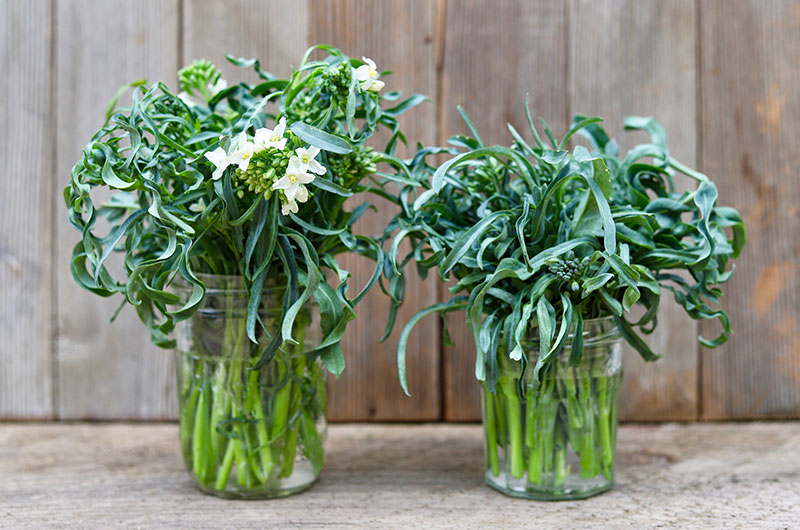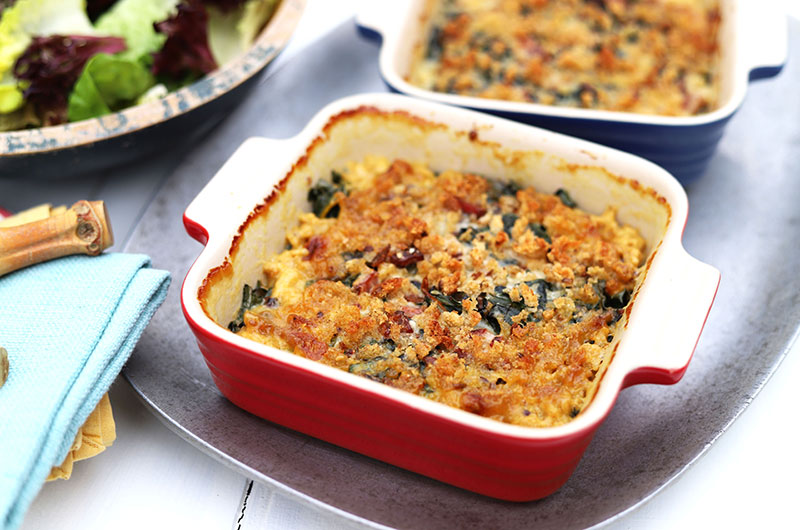This year, the Johnny’s Selected Seeds catalog has fifty-seven varieties of greens that you can grow and harvest as “baby” greens. I am going to plant forty-nine of them. Just kidding. But I am going to plant a few, and you should too. Here’s why: you can be eating a salad bowl full of homegrown baby greens in less than thirty days. That would be late April if you sowed the seeds in late March. By comparison, you’d be waiting another two months before peas and strawberries and baby zucchinis were hitting your plate. That’s a long time to be embracing rhubarb and chive blossoms as your lone backyard edibles – unless you had some greens in the ground. As a bonus, you’d also have leafy greens big enough to cook with in less than fifty days.
When I was a farmer, I couldn’t have opened my farm stand before the Fourth of July if it weren’t for leafy greens such as arugula, kale, mustard, baby bok choy, and Swiss chard. I am indebted to them. Picked young, they make excellent salad ingredients, and I sold them individually and in mixes with young lettuces. Then, as the greens matured and leaves grew bigger, I sold bags of “teenage” leaves (usually about six to eight inches long), which were perfect for the sauté pan. You rarely see these mid-sized greens in grocery stores, so growing them is a treat for the home chef. They’re big enough to cook, but still tender enough that all they really need is a quick kiss of heat, or even just a warm dressing poured over them.
Lastly, I, of course, sold bunches of mature greens – those impressive leaves with sturdy stalks that add big flavor to soups, that make a great filling for a quesadilla, a tart, or a baked pasta, or that can star in a baked dish like the creamy gratin recipe I’ve included below. (That is a recipe that will convert even the most strident greens-dissenters!) And while the biggest leaves need longer cooking times, there is an exception: as long as you slice them very thin, you can toss them into stir-fries and sautés. When thinking about flavors to pair with your greens at any stage, remember they love garlic, ginger, chilies, creamy cheeses (feta, goat cheese), citrus (lemon, orange, blood orange), toasted nuts, and, of course, salty cured meats from pancetta to chorizo.
Though I’m now a square-foot gardener instead of a farmer, greens still excite me, not only because they grow so well in our cool spring weather, but because the sheer variety to choose from means I can get really creative, even in a small space. I can plant spoon-shaped Asian tatsoi and scarlet frills mustard next to serrated mizuna and spiky sylvetta arugula.
I always try something new; this year it will be spigariello, or leaf broccoli. I learned about it last spring from Rusty Gordon at Ghost Island Farm in West Tisbury, where I bought mature bunches of it. But spigariello, like all the varieties of kales and mustards and Asian greens, and even many Swiss chards and beet greens and chicories, can be harvested as baby greens.
To sow the seed for future baby green salads, I like to broadcast each variety in a square foot or two of space. Or scatter along closely spaced rows. (Or sow in a patio pot right outside your kitchen door.) For baby greens, you want to overplant so that you get a dense thatch. You can snip a swath of them when they’re just a few inches high; as long as you cut above the first branching leaf, they will grow back. You can also harvest whole baby plants to leave room around the remaining plants to mature into cooking greens.
You have two choices when starting greens in the spring. You can sow seeds inside in individual cell packs and transplant them outside. This is a good strategy if you want to get an especially early start and if you want to nurture a few sturdy plants to produce teenage and mature leaves for several months. The other option – direct seeding in the garden – is a great option for producing a larger harvest of baby greens. (Sometimes I do both!)
The key to germinating any vegetable seed outside is planting it in the right temperature soil. Fortunately, many greens – especially arugulas, mustards, and spinach – will germinate when the soil reaches 45 degrees (practically no other vegetable seed will do that), which is why we can plant them here in March.
But the number one thing you can do to ensure good germination of your greens (other than to keep the bed moist, but not sopping wet) is to cover your beds with fabric row cover, held aloft by a few metal or plastic hoops. The row cover will trap some heat – and a bit of moisture – to provide a little warmer atmosphere. The soil will be a few degrees warmer under the hoops, which means you can plant a little sooner. And the greens will grow slightly faster under the cover too.
Depending on the weight of the row cover, it can protect from frost or an unexpected late snow. And all row cover deters flea beetles, the white moths that lay cabbage worms, and other bugs that like to eat holes in greens. (It won’t keep out critters, though – you need a fence for that!)
Finally, keep in mind that if you leave some space in your garden, you can plant greens in succession. In other words, you can sow a patch of seeds every week or two, meaning you’ll always have a new batch of greens coming along. This works up until the very hot weather arrives. While many mature greens will “bolt” (send up a tough stem and start flowering) in hot weather, some will germinate and produce young greens for a few weeks before bolting. So succession planting is a way to have some greens, even in high summer.
And with succession planting, you can have your baby greens and eat your gratin too! “All greens, all the time” is my motto. Didn’t you say you wanted to eat a more plant-based diet? Exactly.
-








